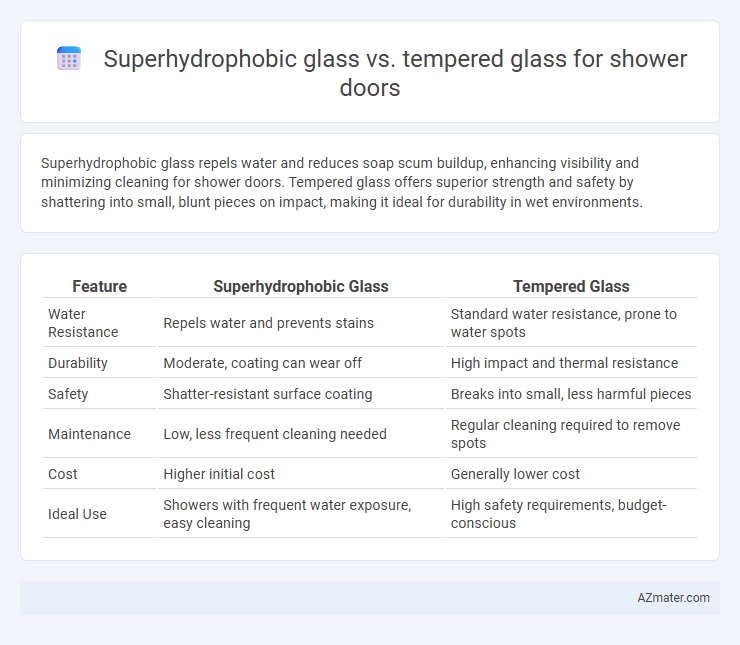Superhydrophobic glass repels water and reduces soap scum buildup, enhancing visibility and minimizing cleaning for shower doors. Tempered glass offers superior strength and safety by shattering into small, blunt pieces on impact, making it ideal for durability in wet environments.
Table of Comparison
| Feature | Superhydrophobic Glass | Tempered Glass |
|---|---|---|
| Water Resistance | Repels water and prevents stains | Standard water resistance, prone to water spots |
| Durability | Moderate, coating can wear off | High impact and thermal resistance |
| Safety | Shatter-resistant surface coating | Breaks into small, less harmful pieces |
| Maintenance | Low, less frequent cleaning needed | Regular cleaning required to remove spots |
| Cost | Higher initial cost | Generally lower cost |
| Ideal Use | Showers with frequent water exposure, easy cleaning | High safety requirements, budget-conscious |
Introduction to Shower Door Glass Options
Superhydrophobic glass and tempered glass are popular options for shower doors, each offering unique benefits. Superhydrophobic glass features a water-repellent coating that prevents water spots and reduces cleaning frequency, enhancing durability and clarity. Tempered glass provides superior strength and safety through heat treatment, minimizing the risk of breakage and injury in the bathroom environment.
What is Superhydrophobic Glass?
Superhydrophobic glass features a nano-coating that creates an ultra-water-repellent surface, causing water droplets to bead up and roll off quickly. This reduces water stains, soap scum, and mineral buildup, making shower doors easier to clean and maintain. In contrast, tempered glass is heat-treated for strength and safety but lacks water-repellent properties, requiring more frequent cleaning to prevent water spots.
What is Tempered Glass?
Tempered glass is a type of safety glass processed by controlled thermal or chemical treatments to increase its strength compared to standard glass. When broken, tempered glass shatters into small, blunt pieces that reduce the risk of injury, making it ideal for shower doors where durability and safety are crucial. Its enhanced resistance to impact and thermal stress ensures longevity and reliability in wet environments.
Key Features of Superhydrophobic Glass
Superhydrophobic glass for shower doors features an ultra-water-repellent coating that prevents water droplets from adhering, ensuring clear visibility and reducing water stains and soap scum buildup. This self-cleaning property significantly lowers maintenance efforts compared to tempered glass, which primarily offers enhanced strength and shatter resistance but lacks hydrophobic protection. The advanced nanostructured surface of superhydrophobic glass enhances durability against corrosion and mineral deposits, making it a superior choice for long-term clarity in wet environments.
Key Features of Tempered Glass
Tempered glass for shower doors offers enhanced safety through its heat-treated process, which increases strength and causes it to shatter into small, blunt pieces rather than sharp shards upon breakage. This glass provides excellent resistance to impact and thermal stress, making it ideal for high-use bathroom environments. Its surface is smooth and easy to clean, though it lacks the water-repellent properties found in superhydrophobic glass.
Durability Comparison: Superhydrophobic vs Tempered Glass
Superhydrophobic glass features a nano-coating that repels water and reduces staining, enhancing its resistance to water damage and corrosion over time; however, this coating may wear off and require reapplication to maintain performance. Tempered glass, known for its thermal and impact strength, offers superior durability by resisting cracks and shattering under stress, making it highly reliable for shower door use. While tempered glass provides greater overall structural durability, superhydrophobic glass excels in maintaining cleanliness and minimizing water-related deterioration.
Water and Stain Resistance: Which Performs Better?
Superhydrophobic glass outperforms tempered glass in water and stain resistance for shower doors due to its specially engineered surface that repels water droplets, preventing buildup and stains. The advanced nano-coating on superhydrophobic glass ensures faster drying and reduced mineral deposits compared to the porous surface of tempered glass, which is prone to water spots and soap scum. While tempered glass offers superior strength and safety, superhydrophobic glass excels in maintaining clarity and cleanliness with minimal maintenance.
Maintenance and Cleaning Needs
Superhydrophobic glass for shower doors significantly reduces water spots and soap scum buildup by repelling water and preventing mineral deposits. Tempered glass, while stronger and more impact-resistant, requires frequent cleaning with specialized products to avoid streaks and hard water stains. Choosing superhydrophobic glass minimizes maintenance efforts and extends the time between cleanings, making it ideal for busy bathrooms.
Cost Analysis: Superhydrophobic vs Tempered Glass
Superhydrophobic glass typically incurs higher upfront costs than tempered glass due to advanced coating technologies that enhance water repellency and reduce cleaning needs. Tempered glass remains more budget-friendly, offering durability and safety without additional surface treatments. When assessing long-term value, superhydrophobic glass can lower maintenance expenses and preserve clarity, potentially offsetting the initial investment compared to traditional tempered glass.
Choosing the Best Glass for Your Shower Door
Superhydrophobic glass offers superior water repellency, reducing water spots and soap scum buildup, making it ideal for low-maintenance shower doors. Tempered glass, known for its strength and safety, provides durability and shatter-resistance, essential for withstanding daily use in a bathroom environment. Selecting the best glass depends on balancing easy cleaning with impact resistance to ensure longevity and aesthetic appeal in your shower enclosure.

Infographic: Superhydrophobic glass vs Tempered glass for Shower door
 azmater.com
azmater.com